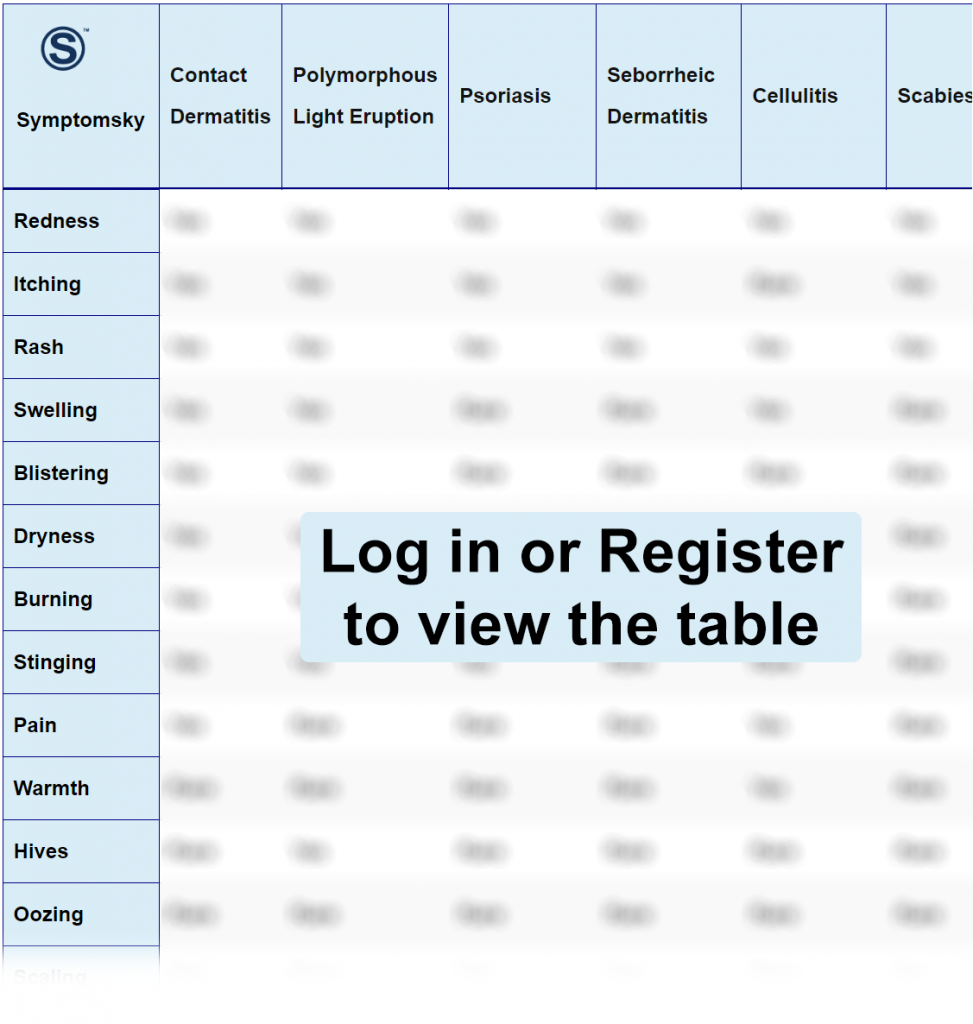Contents
- 1 Contact Dermatitis Differential Diagnosis Table:
- 2 How To Distinguish Contact Dermatitis from Other Diseases
- 2.1 Distinguish Polymorphic Light Eruption from Contact Dermatitis – Diagnosis
- 2.2 Distinguish Psoriasis from Contact Dermatitis – Diagnosis
- 2.3 Distinguish Seborrheic Dermatitis from Contact Dermatitis – Diagnosis
- 2.4 Distinguish Cellulitis from Contact Dermatitis – Diagnosis
- 2.5 Distinguish Scabies from Contact Dermatitis – Diagnosis
- 2.6 Distinguish Dyshidrotic Eczema from Contact Dermatitis – Diagnosis
- 2.7 Distinguish Nummular Eczema from Contact Dermatitis – Diagnosis
- 2.8 Distinguish Asteatotic Eczema from Contact Dermatitis – Diagnosis
- 3 Important Red Flags in Contact Dermatitis
Contact Dermatitis Differential Diagnosis Table:

Contact dermatitis is a type of rash that develops when your skin comes in contact with an irritant or something you’re allergic to; the skin usually swells, becomes inflamed, and itchy. Once the irritant or allergen has been identified and removed, it usually takes a few days to clear up on its own.
It’s a type of eczema and it falls into two categories:
- Allergic contact dermatitis: when you get exposed to something you’re allergic to.
- Irritant contact dermatitis: when you touch something irritant such as jewelry, soap, irritant chemicals, etc.
How To Distinguish Contact Dermatitis from Other Diseases
Distinguish Polymorphic Light Eruption from Contact Dermatitis – Diagnosis
A rash that is mainly caused by sensitivity towards sunlight and UV lights, it’s mainly known as an autoimmune disease and can be prevented by sun protection and wearing broad-spectrum sunscreen.
You can differentiate between polymorphic light eruption and contact dermatitis by:
- Simple photo-testing since in contact dermatitis the skin is not allergic to sunlight as in polymorphic light eruption.
Distinguish Psoriasis from Contact Dermatitis – Diagnosis
Psoriasis can easily be differentiated from contact dermatitis by:
- The physical appearance of rash; contact dermatitis appears as inflamed and swelling, while psoriasis appears as scaly patches.
- Biopsy can also be used to differentiate between the two diseases.
Distinguish Seborrheic Dermatitis from Contact Dermatitis – Diagnosis
It’s a common condition that affects the oily parts of the body, such as the face and scalp; it’s what we know as dandruff.
Both seborrheic dermatitis and contact dermatitis are types of eczema:
- Contact dermatitis is usually dry and inflamed, while seborrheic dermatitis is greasy patches.
“Usually, your doctor can easily diagnose and differentiate seborrheic dermatitis.”
Distinguish Cellulitis from Contact Dermatitis – Diagnosis
It’s a serious bacterial infection that affects the skin. It usually appears very inflamed, hot, red, and tender. A skin culture and antibiotics are usually needed for the treatment of cellulitis.
The main difference between cellulitis and contact dermatitis:
- In cellulitis, there’s no itching present, and the inflamed area is usually painful, unlike contact dermatitis.
Distinguish Scabies from Contact Dermatitis – Diagnosis
It’s a skin infestation that is caused by burrowing mites called Sarcoptes scabiei. It causes severe itching and pimple-like skin. And it’s usually contagious and spread by direct contact.
The main difference between scabies and contact dermatitis is:
- The pimple-like skin that appears in scabies.
- Your doctor can confirm scabies by removing a part of the skin and visualizing the mites or their eggs under a microscope to confirm the diagnosis.
Distinguish Dyshidrotic Eczema from Contact Dermatitis – Diagnosis
Also known as pompholyx, it’s also a type of eczema, but it mainly affects the palms of the hands and soles of the feet, causing blisters and a burning sensation. The condition usually goes away on its own or maybe with the use of moisturizing creams.
- Contact dermatitis usually appears in one part of the body where the allergen or the irritants came in contact with, while dyshidrotic eczema usually affects both sides of the body.
Distinguish Nummular Eczema from Contact Dermatitis – Diagnosis
Also known as discoid eczema, it’s also a type of eczema. It is characterized mainly by coin-shaped lesions. Its underlying cause is not clear, but it usually happens with people with dry skin or in winter.
- Your doctor will usually differentiate nummular eczema from contact dermatitis by visualizing the coin-shaped lesions of nummular eczema.
Distinguish Asteatotic Eczema from Contact Dermatitis – Diagnosis
It’s a type of eczema that usually affects geriatrics and old people. It’s mainly because of water loss in the epidermal layer of the skin. It’s also known as xerotic eczema, and the skin usually appears dry, cracked, and itchy.
- Usually, age plays a big factor in differentiating between contact dermatitis and xerotic eczema.
- Besides the known cracked dry skin that appears in xerotic eczema and not in contact dermatitis.
Important Red Flags in Contact Dermatitis
There is no definite cure for contact dermatitis. The best way for prevention is to avoid coming in contact with any known allergy you have or irritants that caused you contact dermatitis before.
Wash your hands directly if you come in contact with any allergen or irritant, and don’t worry, it’s not contagious.
